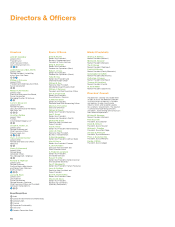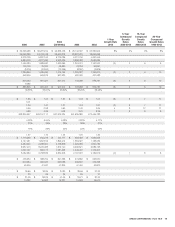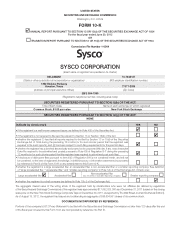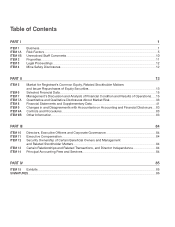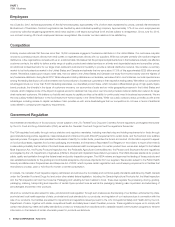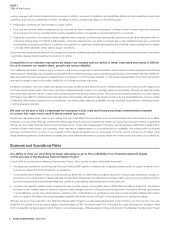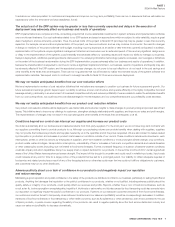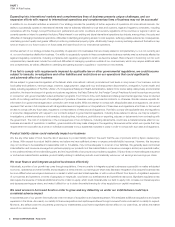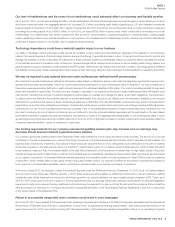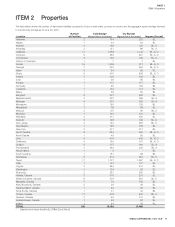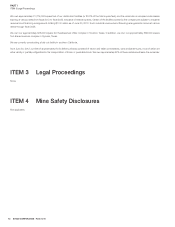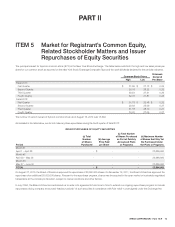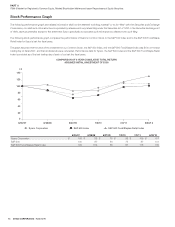Sysco 2012 Annual Report Download - page 28
Download and view the complete annual report
Please find page 28 of the 2012 Sysco annual report below. You can navigate through the pages in the report by either clicking on the pages listed below, or by using the keyword search tool below to find specific information within the annual report.
SYSCO CORPORATION-Form10-K 5
PARTI
ITEM1ARisk Factors
We are also subject to regulation by numerous U.S. and Canadian federal, state, provincial and local regulatory agencies, including, but not limited to, the
U.S. Department of Labor and each Canadian provincial ministry of labour, which set employment practice standards for workers, and the U.S. Department
of Transportation and the Canadian Transportation Agency, which regulate transportation of perishable and hazardous materials and waste, and similar
state, provincial and local agencies.
Most of our distribution facilities have ammonia-based refrigeration systems and tanks for the storage of diesel fuel and other petroleum products which are
subject to laws regulating such systems and storage tanks. Although we are subject to other U.S. and Canadian federal, state, provincial and local provisions
relating to the protection of the environment or the discharge of materials, these provisions do not materially impact the use or operation of our facilities.
Compliance with these laws has not had, and is not anticipated to have, a material effect on our capital expenditures, earnings or competitive position.
General
We have numerous trademarks that are of signifi cant importance, including the SYSCO
®
trademark and our privately-branded product trademarks that
include the SYSCO® trademark. These trademarks and the private brands on which they are used are widely recognized within the foodservice industry.
Approximately half of our privately-branded sales are from products labeled with our SYSCO
®
trademark without any other trademark. We believe the loss
of the SYSCO® trademark would have a material adverse effect on our results of operations. Our U.S. trademarks are effective for a ten-year period and
the company generally renews its trademarks before their expiration dates unless a particular trademark is no longer in use. The company does not have
any material patents or licenses.
We are not engaged in material research and development activities relating to the development of new products or the improvement of existing products.
Our sales do not generally fl uctuate signifi cantly on a seasonal basis; therefore, the business of the company is not deemed to be seasonal.
As of June30,2012, we operated 185 distribution facilities throughout the UnitedStates, Canada and Ireland.
ITEM1A Risk Factors
The following discussion of “risk factors” identifi es the most signifi cant factors that may adversely affect our business, operations, fi nancial position or future
fi nancial performance. This information should be read in conjunction with Management’s Discussion and Analysis of Financial Condition and Results of
Operations and the consolidated fi nancial statements and related notes contained in this report. The following discussion of risks is not all inclusive but
is designed to highlight what we believe are the most signifi cant factors to consider when evaluating our business. These factors could cause our future
results to differ from our expectations expressed in the forward-looking statements identifi ed on page37 and from historical trends.
Industry and General Economic Risks
Periods of signifi cant or prolonged infl ation or defl ation affect our product costs and may negatively impact our profi tability
Volatile food costs have a direct impact on our industry. Periods of product cost infl ation may have a negative impact on our profi t margins and earnings
to the extent that we are unable to pass on all or a portion of such product cost increases to our customers, which may have a negative impact on our
business and our profi tability. In addition, product cost infl ation may negatively impact consumer spending decisions, which could adversely impact our
sales. Conversely, our business may be adversely impacted by periods of product cost defl ation because we make a signifi cant portion of our sales at
prices that are based on the cost of products we sell plus a percentage markup. As a result, our profi t levels may be negatively impacted during periods
of product cost defl ation, even though our gross profi t percentage may remain relatively constant. Our estimate for the infl ation in Sysco’s cost of goods
was 5.5% in fi scal 2012, compared to estimated infl ation of 4.6% in fi scal 2011 and defl ation of 1.5% in fi scal 2010.
Our results and fi nancial condition are directly affected by the volatility in the global economic environment and local
market conditions and low consumer confi dence, which can adversely affect our sales, margins and net income
The foodservice distribution industry is characterized by relatively high inventory turnover with relatively low profi t margins and is especially susceptible to trends in
economic activity, such as the recent global recession. The global economic environment has been characterized by weak economies, persistently high unemployment
rates, infl ationary pressures and extreme volatility in fi nancial markets worldwide, which has been exacerbated by the signifi cant uncertainty associated with the


